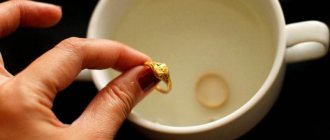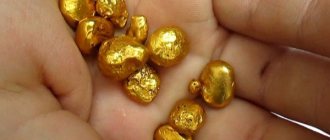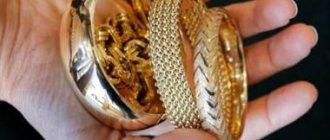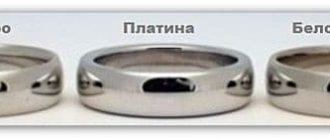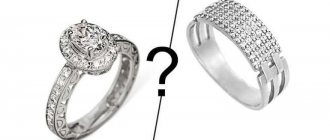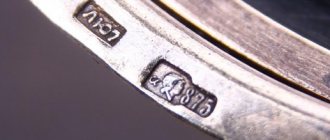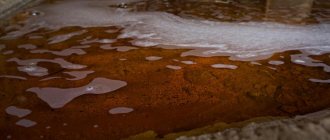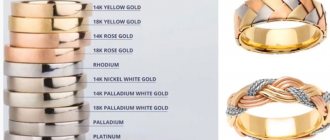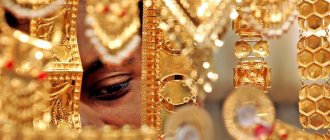Everyone wants to figure out whether a piece of jewelry is gold or gilded, or does not even have a hint of gold. After all, the desire to own this metal is strong in us. And no one wants to be deceived. Before you understand how to distinguish gold from gilding and different types of fakes, it is worth thinking about what you want to achieve by buying this or that gold jewelry.
It is possible that your goal is only to have a gold-appearing appearance. After all, the love for gold jewelry is ancient. We can say that it has been cultivated in us since childhood through fairy tales, feature films and documentaries. As we grow up, we ourselves begin to distinguish the social status of our interlocutor by the number and type of jewelry. And this is how we were brought up: the more gold we see, the higher we evaluate the position of our opponent.
Already in adulthood, we ourselves educate each other, encouraging us to compete in status things, including gold jewelry. And the desire to appear to have a higher status is understandable. This is what often pushes people to buy fakes at a bargain price.
Do you want to buy a gold ring or other jewelry, not only to emphasize your importance in appearance to your friends and colleagues, but also to gain self-confidence? Then, of course, it is necessary to understand the types of hallmarks on gold, and the options to distinguish where the gold is and where the gilding is. And the fact is that the jewelry is definitely not made of copper or other alloys.
Methods for determining gold and gilding
Determining where there is gold and where there is just gilding, or the absence of the precious metal even in minute quantities, is not so difficult. It is enough to use proven methods.
Before we tell you how to distinguish real gold from a fake, you should understand how it is marked. After all, if you buy a gold product in a well-known store, then you will not need to bother with checks. It will be enough to look at the labeling.
The designations accepted in Ukraine include the brand. It can be on the inside or outside of the decoration, depending on its type. The mark consists of a hallmark and a trident coat of arms. If you see such a print, and, as we have already said, you choose it in a trusted store, you can have no doubt about the authenticity of the jewelry.
However, do not forget that genuine gold jewelry can be of completely different purity. And they are also worth understanding.
The most common gold samples:
- 585 – first place in terms of presence on the jewelry market. Jewelers have identified an alloy containing 58.5 parts of gold per weight of the item as the most optimal option. This is the only way to ensure maximum durability and attractive appearance of gold. This hallmark is used in most jewelry around the world.
- 750 - second place. An alloy containing as many as 75 parts of gold is, of course, more expensive. Only such decoration cannot be considered durable. It can be made to order, and the wearer will be encouraged to wear the jewelry on special occasions. The 750 grade product is not suitable for daily wear. Accordingly, it is rarely found in specialized stores. If there are such decorations, then they are an order of magnitude smaller than the number of 585 samples.
- 375 - third place. The most inexpensive version of gold, which can, in principle, be considered gold and used in jewelry. Jewelry of this standard is rarely found in large stores. If there is, then in even smaller quantities than jewelry of 750 standard.
An addition to part of the gold, i.e. The ligature is an alloy of different metals. The 585 uses copper, palladium, nickel and silver. For 750, platinum is also added to the above. But in 375-carat gold jewelry the ligature contains only copper and silver.
Application methods
There are many known methods of gilding. The choice is determined primarily by the nature of the surface and the professionalism of the craftsman.
Fire or mercury
One of the very first methods that was used for gilding temple domes. Its essence is that a special mixture based on mercury was prepared, which was subsequently evaporated. Due to the danger to the health and life of the master, this technique is a thing of the past.
Oil based
Another name for the method is Mordan gilding, from the name of a special glue. The method is suitable for both interior and exterior work. Mordan can be purchased in specialized online stores.
Clay based
Clay-based gilding (polyment) is used only for wood and is not suitable for exterior decoration. In the old days, this was one of the most difficult and time-consuming methods, since the preparation of polyment required rare and very expensive ingredients at that time, including whale oil. The mixture was diluted using egg white. Now you can find ready-made mixtures on sale.
Water-synthetic
For this method of gilding, mixtures based on water are used. The advantage is that you can quickly prepare the surface. The gold-plated product is glossy and does not require final polishing.
Garlic
One of the oldest methods. Fresh garlic juice was squeezed onto the surface. After it dried, the surface was polished, moistened and gold leaf was applied. According to experts, this method gives the gilding a special shine.
Gilt hallmarks
When you set out to buy a gold-plated ring or earrings, you should not think that there will be no mark. Even though such jewelry will only have gold plating, it must be marked. And they do this all over the world.
The test for silver with gilding may be familiar to you from some of your jewelry. But, unfortunately, with gold-plated products not everything is as simple as with gold. After all, they are much more common among jewelers and, accordingly, in stores.
There are three most common types of hallmarks on gold-plated products:
- Gold plated – the thinnest gold coating is applied using electrolysis.
- Gold filled – gold plating is fused onto any metal, most often silver. It differs from the product with the first sample in a thicker layer of gold.
- Gold soldered – very inexpensive products stand out with this gilding. After all, a breakdown with this designation speaks of a tin-lead inclusion.
It turns out that even if you want a gold-plated ring or something else, you will still be protected from counterfeiting if you buy the product in a specialized store. You should not think that hallmarks are placed on someone’s whim. The State Assay Office monitors manufacturers' compliance with all jewelry standards.
Kinds
The most common type is still gilding. Also in recent years, gold leaf gilding has become popular among decorators, which is much more accessible and cheaper.
Gold leaf
Gold leaf is 960-carat metal, rolled out to a thin sheet. In Rus', gold leaf was traditionally used to cover the domes of churches. In Russia it is sold in the form of books of 60 sheets with an area of 10 cm2 each.
The thickness is not regulated, but the most popular sheets are 10 times thinner than a human hair. It is used to decorate objects of art and for interior design. For outdoor decoration (fountains, domes, sculptures) thicker sheets are used.
Potal
Potal is a replacement for the usual gold leaf. It appears as gold sheets or strips and is an alloy of copper and zinc or aluminum. There is a potal imitating gold, silver and bronze. A drawing can be applied to the sheets. You can find gold leaf on sale in the form of multi-colored crumbs.
What are their differences?
The main difference between gold and gold is that it does not contain precious metal. This naturally affects its price: gold leaf is much cheaper. Without a protective coating, it may fade over time.
Methods for calculating counterfeit gold
Considering in a store what type of jewelry you want is the easiest way to distinguish gold from a fake. But if you bought jewelry from a store you've never heard of, or it was just given to you as a gift, then you need to know how else you can spot a fake.
Some proven ways to identify gold at home. They do not give a 100% guarantee, but in some cases they will eliminate doubts.
- Bite the decoration. All common grades assigned to gold indicate the content of the yellow metal itself. And there is not a single common test that would make jewelry as hard as diamond. The inherent softness of gold still remains. Therefore, you can easily distinguish the marks of your teeth if the jewelry is truly gold.
The exception is a fake with the addition of lead. There will also be a mark on it.
- Attach a magnet. Gold is a non-magnetic material, as is the ligature used in making jewelry. Accordingly, it is useless to apply a magnet to gold - it will not stick.
Counterfeits often use copper, lead and other metals used in the alloy. They are also not magnetic.
- Dip in vinegar or alcohol. Nothing will happen to gold, but metal similar to it will darken.
There is no catch in this method. No other cheap metal can withstand household acid or rubbing alcohol.
- Scratch. Should only be used as a last resort. After all, no matter what the jewelry turns out to be, you will still want to continue wearing it. Therefore, it is worth scraping where it will not be noticeable.
There is no way to hide metal under gold. If another metal is visible in the place of the scratch, then you definitely have at least a gilded piece of jewelry, and at most, the top layer is not even gilded.
- Heating. A little dangerous way. It is worth arming yourself with a special tool so as not to get burned. If after this procedure there are no stains on the gold, it is genuine.
The catch may be in the sample. Nobody canceled the deception with a fake brand. After all, 750 is more expensive.
Methods by which one could check a fake if the product is plated with gold are not relevant. Few people will counterfeit it because of the cost of the product. Passing off the same copper as gold-plated jewelry is simply not profitable and happens very rarely.
With gilding, jewelry can act as a counterfeit product in gold. Then all the methods described above will work.
Gold plating methods at home
With certain skills, compliance with safety precautions and the presence of a well-ventilated room, gilding can be done independently at home.
Preparation and use of gold chloride
Procedure:
- Prepare aqua regia.
- Dissolve any gold item in it.
- Carefully evaporate to a dry residue.
Attention: the process must be carried out very carefully, since acid fumes can cause serious harm to the respiratory tract, and there is also a high risk of chemical burns to the skin.
- Mix the resulting gold chloride with chalk and a solution of potassium cyanide to a mushy state.
- Using a brush, cover the product.
- After the surface has dried, it must be thoroughly washed and polished.
Application of zinc contact
If a thicker layer is needed, then zinc is used. It is also necessary to prepare gold chloride for it.
Procedure:
- Clean the item thoroughly and degrease it.
- Prepare the composition by mixing gold chloride with carbonic potassium, yellow blood and table salt in water.
- Heat.
- Place the item to be gilded in a container with a warm mixture.
- When the products are already in the solution, place a zinc stick in the container.
- Rinse, dry and polish.
If necessary, the product is covered with a protective layer.
Galvanic method
The galvanizing method is similar to galvanizing, but produces a more durable coating. By changing the composition of the solution, you will get different shades of gold. You will need a current rectifier and any glass container that can withstand high temperatures.
Procedure:
- Clean, degrease the product, sand it using paste and sandpaper.
- If the product is made of steel, zinc or tin, first coat it with copper.
- Prepare electrolytes from water, sodium phosphorus, gold chloride, potassium cyanide and sodium disulfide.
- Heat the resulting solution to 60 °C.
- Install the anode.
Electroplating takes from 12 to 16 hours. At the end of the process, the product is dried on sawdust and polished.
If gilding of a small surface is required, it is easier to purchase a special galvanic pencil.
Gilding on the Gulfarba
Gilding “on Gulfarba” allows you to get a matte finish. Gulfarba is a mixture of varnish, drying oil, and pinene. The surface is treated with Gulfarba, and the next day a layer of gold leaf is applied to it. Thanks to the solvent in the composition, the surface becomes matte.
How not to be deceived by gilding
The gold layer on the base metal is always small. Therefore, during any experiment with gilding, technical or chemical, the bottom layer will always give itself away. However, this will not show whether the metal in front of you is gold or another metal.
If you really want to understand whether your jewelry is gold-plated or just has the appropriate color, then only a jeweler can help you. In order not to spoil the color of the jewelry with reagents, most often craftsmen make an invisible puncture. This is how they calculate the thickness of the gilding. And to determine whether this coating can even be called gold, they can scrape off a little of the top layer in an inconspicuous place and separately treat this powder with chemicals.
Schiller test value
Of great importance in the differential diagnosis of normal and atypical patterns is the color shade and the clarity of the zone boundaries.
The presence of clear boundaries indicates an unfavorable situation. Benign lesions usually have less sharp, blurred contours.
Thus, the test expands diagnostic capabilities and allows:
- preliminary assess the degree of damage, size, depth and number of pathologically changed areas;
- determine patient management tactics;
- evaluate the effectiveness of treatment measures,
- to clarify the features of changes in stratified squamous epithelium under various physiological conditions (pregnancy, menopause, contraception).
Immunoglobulins class G to SARS-CoV-2 (IgG)
IgG can be detected in the blood from approximately 18-21 days after infection, and their level can remain high for a long period of time. The presence and level of IgG antibodies in the blood can serve as a basis for drawing the conclusion that the infection entered the body in the past. These indicators make it possible to determine the presence of a specific reaction of the immune system. Here you can get tested for Covid and receive information about the presence of antibodies as soon as possible with the appropriate certificate, in Russian and English.
Express tests
In terms of time, rapid tests are the best option; with their help, you can find out in 15 minutes whether there are specific antibodies to the SARS-CoV-2 virus in the blood. The main advantage of this testing method is speed, but there is a possibility of obtaining an unreliable result. That is why they are not accepted as legitimate confirmation of immune status.
The ELISA test for Covid takes longer, but it has high sensitivity, which significantly increases the accuracy of the result obtained; it can be used to detect specific immunoglobulins in the blood serum.
Who is recommended to undergo ELISA testing?
ELISA tests act as a universal method of mass screening of the population. This test is primarily carried out by patients with symptoms of ARVI, pneumonia, contact persons, patients requiring planned hospitalization or surgery, staff of medical institutions interacting with patients with COVID-19 and representatives of other industries where there is a high risk of infection during the performance of work duties .
We offer testing for Covid in Rostov at our medical center for clients who interact with a large number of people. You can choose the production time and the system by which the study will be conducted. Contacting us will help you identify the disease in a timely manner and begin its treatment.
The cost of all services of the medical center can be viewed in the “Price” section or by calling the 24-hour hotline.
Antibodies/immunoglobulins are the basis of the body’s defense
Antibodies or immunoglobulins (Ig) provide the body's defense against viruses, bacteria and other agents of infection. When pathogens enter the body, the human immune system starts the process of producing specific proteins; they destroy the threat and remember the infection. If the infection enters the body again, the process of producing antibodies will begin, which will quickly eliminate the threat without consequences for the body.
Determination of antibodies in the blood is informative evidence of a current or past infectious process, which makes it possible to assess the stage of development of the infection. The level of antibodies and the dynamics of the antibody response is individual; in other words, it manifests itself differently in each person.
These indicators are greatly influenced by the state of the human immune system, the presence of concomitant diseases and additional factors. With COVID-19, the process of formation of immunoglobulins takes on average 7-14 days after contact with the virus. Taking into account the fact that antibodies are not produced in sufficient quantities from the moment the virus enters the body, an immunoglobulin test may show a negative result, since the procedure can be performed at a time when the body has not yet had time to form an immune response - class M immunoglobulins to SARS-CoV-2 (IgM).
Practice shows that they can be detected no earlier than one to two weeks from contact with the pathogen (no earlier than 5 days from the onset of symptoms). The general period of possible detection of class M antibodies in most cases is about 2-4 months. During this period of time, the process of changing IgM antibodies to IgG occurs. Based on this, the detection of class M antibodies may indicate that the pathogen entered the body during a specific time period. In this case, the test result cannot be used to form diagnostic conclusions. This is due to the fact that the level of antibodies and the dynamics of the antibody response are strictly individual.
